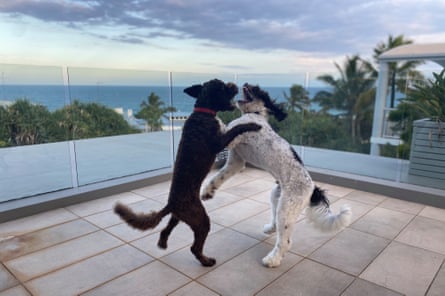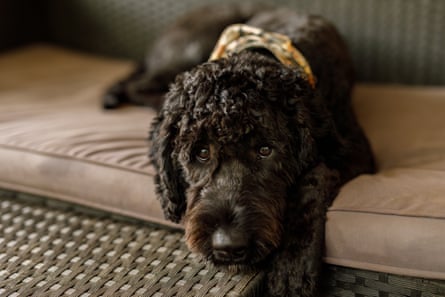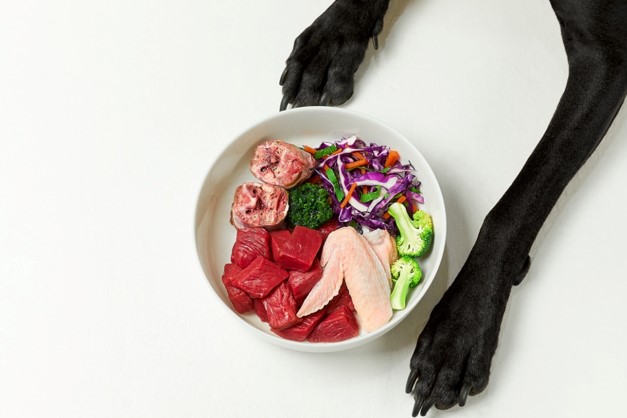‘Our little $7,000 dog’: inside Australia’s oodle boom | Dogs
“Look at them, they’re like a box of assorted chocolates,” my friend Rachel sometimes says when we’re out walking. Her Iggy, bouncy and swarthy as a fine dark chocolate. Fran’s tubby, tiny Frankie, fair as a white chocolate truffle. My mocha-toned Lola, prancing and skittish. We gush a bit. “Look at them,” we say, “so cute!”
A groodle, a cavoodle and a labradoodle went for a walk – it could almost be a joke’s opening line. And perhaps that’s what the man who passed Lola the other day in Sydney’s Centennial Park was thinking when he shouted, “What a strange-looking dog!” (Note: she’s not.)

Oodles – poodles crossed with pure-bred dogs (AKA crossbreeds) – polarise opinion. Purists, the breeders of pure-breds, often dislike oodles for, among other things, the fact that their breeders can command crazy prices, even though their mutts often have opaque genetic lines. And the righteous are prone to judgment. “Get a rescue dog,” they say. (I looked at rescues but most seemed to be staffordshire bull terriers or some mix thereof and, with apologies to staffie fans, I couldn’t find it in me to share a life with one.)
So it is that my labradoodle Lola comes with conflicting feelings: bundled in with adoration is sheepishness, guilt. I’m anything but a designer-dog sort of a person. I stumble over the silly name – “labradoodle” – and sometimes try to obscure her origins by calling her a mutt.
But no matter how I describe her, Lola is part of the explosion in popularity of oodles and an ugly mixed bag of attendant cruelties, price gouging, scams and, some will say, insanity and indulgence.
For a decade or so, the oodle population has been building. New South Wales Office of Local Government figures show registrations more than doubled in 10 years – from 6,691 in 2012 to 14,595 in 2021. (Cavoodles are by far the most popular; in the City of Melbourne, they outnumber labradors.)
Then the pandemic arrived. Diaries emptied. What else was there to do but get a dog? A 2021 Animal Medicines Australia report found more than a million additional dogs had joined households since 2019. Oodle-specific figures aren’t available but a visit to any dog park in the country will confirm the trend: oodley Iggies, Frankies and Lolas are everywhere. And, in the two years since they met as nutty little pandemic puppies, squadrons of shaggy infant oodles have bounced in to bug them.
“Oodles are probably the most common dog that I see,” says Dr Imogen Tomlin-Game, who practises in Sydney’s northern beaches vet clinics and is the chief veterinary officer of RightPaw, a website connecting would-be dog owners with responsible breeders.

Tomlin-Game says cavoodles beat out other crossbreeds in the popularity stakes because of their temperament. “The personality of the Cavalier King Charles spaniel comes through.”
Dr Anne Quain, a lecturer in veterinary science at the University of Sydney and companion animal practitioner in the city’s inner west, has also seen “a massive jump” in the number of oodles. Owners tell her they wanted a low-shedding and hypoallergenic dog, although it doesn’t always work out that way: “We still see people who are allergic to those dogs.”
She believes there are other reasons for oodles’ popularity: “They look like teddy bears – that’s part of the charm. And I hate to say it, but breed choice is heavily influenced by what’s in the media and so many people now have Instagram channels devoted to their dogs, and oodles are up there.” (Note: Lola does not have her own Instagram account but she has annexed mine.)
At the height of the pandemic, Australia was gripped by oodle-mania. Nicole, the owner of Belloui Labradoodles in Brookfield, Brisbane, says that at one point she had up to 500 people on a waitlist. “It was insane, people were begging; I had to take my phone number off everything because I couldn’t manage the calls.” Nicole, who prefers not to give her last name, says people were offering to pay more than her set price. “I’m like, ‘No, that’s not how this works; fill your application in and just be patient.’”
She says breeders prospered during the pandemic and, even now, “there’s definitely money to be made if you’re doing it properly”. Nicole, who also breeds cavoodles, moodles (toy or miniature poodles crossed with maltese) and sheepadoodles (old English sheepdog), increased her prices during the pandemic. Her labradoodles are $5,000. (I paid $,2800 for Lola at the beginning of 2020.) Cavoodles are $6,200, a case of supply and demand, because more people want them but they have smaller litters (an average maximum of five puppies, compared with labradoodles’ eight or nine) and often require expensive caesareans.
Quain was aware of some breeders lifting their prices from about $2,000 to $10,000 during the pandemic.
Though the heady days of five-figure cavoodles seem to be behind us now, prices haven’t fallen to pre-pandemic levels. A scan of oodle breeders on RightPaw showed me I could buy Lola a companion moodle for between $3,500 and $5,000 (from Bogan Moodles), a groodle from Bundaberg in Queensland for $4,000, or a labradoodle for $5,000.
But wanting an expensive dog that looks like a teddy bear has consequences. Wally Conron, who in 1989 crossed a standard poodle and a labrador to create a hypoallergenic guide dog, the first labradoodle, has said he “released a Frankenstein’s monster”. In 2019 he told the ABC that “the biggest majority are either crazy or have a hereditary problem”.

Says Quain: “The problem is, when they come into the vet and they’ve paid for a $10,000 dog they believe they’ve got this high-end product, but it’s just a dog, right? It doesn’t mean that they don’t have health problems. It doesn’t mean they don’t have behaviour problems.”
She has seen a handful of eight-week-old oodles with severe behavioural issues, including cavoodles that are extremely aggressive. Cavoodles’ health problems can include heart disease due to congenital mitral valve issues. In labradoodles, epilepsy, hip dysplasia and elbow problems can emerge. They are also prone to ear infections. (Lola has dreadlocks in her ear canals. The vet bills to sedate her to clean them out and the anti-allergy injections? Let’s not go there. Pet insurance? So far, so useless.)
Oodle crossbreeds are not among the 213 dog breeds recognised by Dogs Australia (formerly the Australian National Kennel Council). Nevertheless, some labradoodle breeders are working towards a “standard” to codify the ideal characteristics and temperament. Their puppies are the result of more than one generation of considered breeding between labradoodles, rather than illicit flirtations between poodles and labradors.
Ethical breeders also carry out DNA testing on their breeding adults to minimise the risk of puppies ending up with genetic health conditions.

The popularity of oodles has had other consequences. Even before the pandemic, they were in the crosshairs of puppy farmers. A distressing RSPCA NSW video taken in mid-2019 showed scenes from an operation in which 187 crossbreeds were rescued from a squalid commercial breeding operation. They were “in cramped enclosures, whimpering for a loving touch and kind word”.
Scammers also love oodles. “Breeders started putting their prices up to about $6,000 for cavoodles and scammers went, ‘OK, well, how about we sell them for $3,000,’” says Sandy Trujillo, a former vet nurse who launched Puppy Scam Awareness Australia after she was scammed in 2020. “And so unsuspecting victims obviously went for the $3,000 mark.”
She paid $1,600 for a toy poodle then the “breeder” stopped responding to her. There was no toy poodle.
Typically, scammers post ads for nonexistent animals in online classifieds using photographs and descriptions stolen from genuine breeders’ websites. As Trujillo did, customers often make upfront payments, and may be persuaded to fork out more for unforeseen transportation or medical expenses.

Between January 2021 and February 2022, the Australian Competition and Consumer Commission received 3,680 pet scam reports, with $4.7m lost. Cavoodles were among the most popular animals listed.
RightPaw’s Tomlin-Game says good breeders usually have waitlists and take time to match owners with puppies: “Having puppies available all the time is definitely a bit of a red flag.” Breeders on RightPaw, including numerous oodle breeders, also undertake a verification process that involves a Zoom or FaceTime inspection of their property.
The good news is oodles are not being dumped or surrendered in any volume. Vickie Davy, founder and director of the umbrella rescue group PetRescue, says more oodles are being given up but that’s to be expected given their significantly increased numbers. And, she adds, they’re easy to rehome. “You list them and you get 200 inquiries in a day.”
It’s a happy surprise more oodles aren’t surrendered, given that they don’t always grow according to the label. Lola, at two and a half years old, is insatiable, and, yes, a bit crazy. She’d be out all day if she could be. I often walk her three times a day. She has leapt out the car window in her excitement to get to the dog park (my bad). She has taken flying jumps into lakes to paddle after ducks and over walls into Sydney Harbour.
She is neurotic, intense, obsessive and particular about the company she keeps. She tolerates Iggy and Frankie but Daisy, a dizzy blond labradoodle twice her size, is her one true love.

After dozens of hours watching dogs on YouTube, Daisy’s owners, Felix, a jazz musician and Alex, a medical student, decided they wanted a labradoodle. It would be, the couple concluded, smart, friendly, medium-energy, chill. In December 2020, Daisy moved in. She was meant to be medium-sized but didn’t stop growing. “Our little $7,000 dog,” Felix says. “The biggest shock … the non-stop energy.”
Lola and Daisy go berserk in the park together. They’d play for hours if we didn’t stop them.
When we get home, Lola doesn’t shed fur. Instead, she prances in shaking off a trail of leaf litter, mud, sand and excitement. She looks at me from the throne she chose on the day she moved in more than two years ago – the back of the couch – and I hear her question: What’s next?







